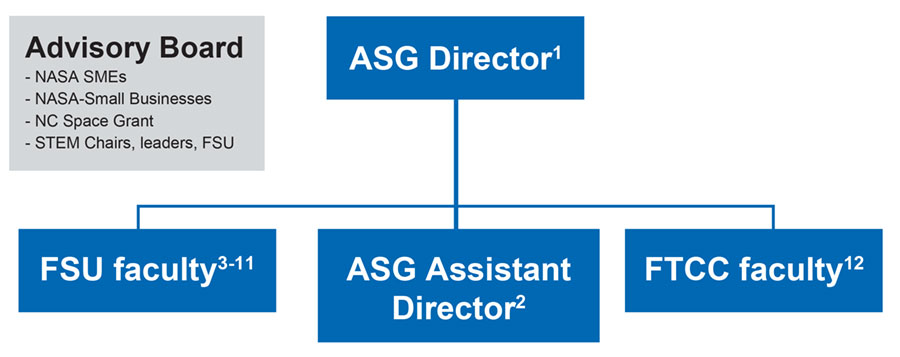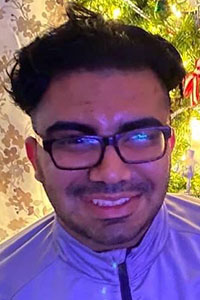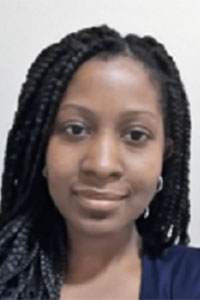Advanced Systems Group
The primary goal of the project titled Planning for Increasing Research and Education in Advanced Systems (PIREAS) awarded to Fayetteville State University (FSU) by NASA's Minority University Research and Education Project (MUREP) Space Technology Artemis Research, or M-STAR Planning Grant, was to create the Advanced Systems Group (ASG) which now serves as a structure to increase FSU capabilities to respond to NASA grant opportunities. The NASA award was announced here. The ASG is comprised of a rapid response team to review and communicate NASA opportunities to faculty, researchers whose interests align with Space Technology Mission Directorate (STMD) priorities, and students working on projects and research that focus on STMD topics. As part of the M-STAR Planning Grant, the initial team identified faculty research interests that align with STMD topics and developed co-curricular programs that supports those topics. The FSU planetarium is now designated as a NASA Informal Education Community Anchor site. After the planning phase FSU won the M-STAR Implementation Grant titled Active and On-demand Multi Robot Perception (AOMRP). See NASA announcement page and FSU news article. The Intelligent Systems Lab hosts the activities of AOMRP.
The organization chart of the opportunity response team, called the Advanced Systems Group (ASG) is shown in Figure 1. The ASG was established as part of the activities supported by PIREAS.
Figure 1: The organization chart of the Advanced Systems Group (ASG). The superscript numbers correspond to members identified in the ASG shown in Table 1.

ASG Member List
The list of members of the Advanced Systems Group (ASG). The superscript numbers correspond to membership categories in the organization chart of Figure 1.
Sambit Bhattacharya1
ASG Director
Professor in Computer Science
Intelligent Systems Lab
sbhattac@uncfsu.edu
(910) 672-1156
Joseph Kabbes2
ASG Assistant Director
Planetarium / Observatory Manager, Instructor
FSU planetarium
jkabbes@uncfsu.edu
(910) 672-1926
Daniel E. Autrey3
Associate Professor / Chair, Department of Chemistry, Physics, & Materials Science
dautrey@uncfsu.edu
(910) 672-1354
Bhoj Gautam4
Assistant Professor in Physical Science
bgautam@uncfsu.edu
(910) 672-1653
Shubo Han5
Professor of Chemistry
shan@uncfsu.edu
(919) 672-1303
Eid Haddad6
Associate Professor of Physiology
ehaddad@uncfsu.edu
(910) 762-2436
Chekad Sarami7
Associate Professor in Mathematics
csarami@uncfsu.edu
(910) 672-1129
Albert Chan8
Professor / Assistant Chair, Computer Science
achan@uncfsu.edu
(910) 672-1517
Lieceng Zhu9
Associate Professor, Biology
lzhu@uncfsu.edu
(910) 672-1655
Abdelmajid Kassem10
Professor, Biology
mkassem@uncfsu.edu
(910) 672-1692
JiaZheng Yuan (John)11
Assistant Professor of Biology
jyuan@uncfsu.edu
(910) 672-1056
Chris Diorietes12
Dean of Math & Science Fayetteville Technical Community College
diorietc@faytechcc.edu
(910) 678-8244
During the PIREAS grant the following opportunities were targeted and they continue beyond the active period of the grant through the AOMRP M-STAR Implementation Grant:
1.3.1 The Advanced Systems Group (ASG) was established The ASG is a multi-disciplinary effort spanning multiple departments. The ASG Committee meets periodically to discuss NASA STMD research opportunities. An external advisory board includes FSU faculty and industry experts. This advisory board meets quarterly to offer direction for ASG activities.
1.3.2 Seed fund to work with JPL was awarded As part of the JPL seed funding program, the ASG project "Multi-sensor mesh positioning with Machine Learning algorithms" was proposed and accepted. These seed funds will provide stipends to support student involvement in AI based positioning research during 2021.
1.3.3 Joint work with the American Natural History Museum was started FSU planetarium manager met with the American Museum of Natural History as regards the OpenSpace Project for use in the FSU Planetarium. OpenSpace will allow visitors to travel through space, viewing data from NASA missions. Our planetarium vendor is working with the OpenSpace team to better integrate the software with our system.
1.3.4 Students received funding from NC Space Grant One Computer Science (CSC) student received research scholarship and two CSC students received the MSI STEM Bridge scholarship. Two of these students have also applied for NASA internships in summer 2021.
1.3.5 ASG faculty worked with NASA SMEs To increase research capabilities ASG faculty worked with NASA SMEs James Harrington (GSFC-6063), Randy Herrera (US 3120), and Mitch Ingham (US 3100) to discuss opportunities and directions aligned with NASA STMD priorities.
1.3.6 ASG faculty started work with industry partners Geisel Software, Inc. is working with ASG faculty to identify mutual areas of interest. At the invitation of Geisel Software faculty worked on a JPL RFI in the area of Data Science. Student internship opportunities in Geisel Software were identified and students were encouraged to apply.
1.3.7 Students started participation in NASA MINDS The ASG has recruited eleven students to participate in the research preparation component of the program. Student members have worked on physical computing projects in preparation for the NASA MINDS robotics work which will begin in Spring 2021. As a result, two student teams have been accepted as part of the NASA MINDS competition.
1.3.8 ASG faculty met NC researchers ASG Biology faculty met with Rafael Loureiro[1] (Assistant Professor of Botany at Winston-Salem State University) and Imara Perera[2] (Research Professor of Plant and Microbial Biology at North Carolina State University) to discuss potential cooperative research in space biology.
1.3.9 ASG faculty participated with FTCC The ASG has partnered with FTCC to give their students the opportunity to participate in ASG student projects and research programs. The goal is to offer a broad range of opportunities in NASA research to underserved students, and to create a pipeline of students who may join FSU degree programs.
1.3.10 ASG faculty discussed multi-disciplinary grant submissions The ASG faculty members will submit a multi-disciplinary research proposal in NASA STMD priority areas to the upcoming NASA M-STAR implementation opportunity. NASA STMD funding opportunities are being monitored to determine future grant options based on expertise and interests of FSU faculty.
1.3.11 Other NASA STMD related opportunities Other NASA STMD related opportunities include further participation in student competitions and holding virtual workshops to discuss ASG mission and various NASA funding opportunities. These workshops will be open to anyone interested in NASA research.
- Sambit Bhattacharya1 is a Professor of Computer Science. He is interested in research on use-inspired Artificial Intelligence and Machine Learning (AIML) and he collaborates with researchers from other disciplines. He develops computational approaches that integrate scientific and engineering knowledge with data driven AIML modeling. Dr. Bhattacharya works on bioimaging applications, and on building predictive models for advanced manufacturing processes. He also researches applications of AIML in geospatial intelligence and robotics built by combining domain knowledge with models learned from data.
- Joseph Kabbes2 teaches Astronomy and performs STEM Outreach through the FSU Planetarium and Observatory, along with presentations around the region. He has 35+ years of experience in Software Engineering and Design, along with experience in Rapid Prototyping using Computer Aided Design and Manufacturing. Mr. Kabbes also has experience in geo-spatial positioning.
- Daniel Autrey3 is an Associate Professor of Chemistry and he teaches general and physical chemistry. He has expertise in Raman spectroscopy, and his research interest is focused on developing two-dimensional nanomaterials (MXenes) as potential substrates for surface-enhanced Raman scattering (SERS) based sensors and photocatalysts, as well as functionalized mesoporous materials for carbon capture applications.
- Bhoj Gautam4 is an Assistant Professor of Physical Science and has a background in chemical and optical sensors, light emitting diodes, and solar cells. Dr. Gautam also has done research in polymer chemistry and perovskite materials using optical spectroscopy.
- Shubo Han5 is a Professor of Chemistry with experience in protein interactions in neurodegenerative diseases, nanomaterials, biosensors, and electrochemistry.
- Eid Haddad6 is an Associate Professor of Physiology and he is experienced in vaccines and immune-enhancers and steroid hormones. Dr. Haddad also has a strong interest in the use of domesticated Avian as an off-world food source and supply of organic material.
- Chekad Sarami7 is an Associate Professor of Mathematics and he teaches Mathematics and Computer Science. He is experienced in Data Science / Analytics and Machine Learning.
- Albert Chan8 is a Professor of Computer Science and his primary expertise is on high performance computing. He also has experience in mobile computing, game computing, and client-server development.
- Lieceng Zhu9 is an Associate Professor of Biology. Dr. Zhu's research focuses on the impact of environmental stresses on resistance of wheat plants to the Hessian fly.
- Abdelmajid Kassem10 is a Professor of Biology with experience in plant genetics and genomics. Dr. Kassem researches genetic and QTL mapping of important agronomic traits in major crops.
- Jiazheng Yuan11 is an Assistant Professor of Biology with substantial experience in genetics, genetics and plant biotechnology. Dr. Yuan's research interesting is focusing on plant breeding, genetic variant determination and gene expression analysis for disease resistance and trait improvement.
- Chris Diorietes12 is the Dean of Mathematics & Science at Fayetteville Technical Community College.
ASG faculty with areas of interest/exploration are listed below.
1Sambit Bhattacharya, 2Joseph Kabbes, 3Daniel Autrey, 4Bhoj Gautam, 5Shubo Han, 6Eid Haddad, 7Chekad Sarami, 8Albert Chan, 9Lieceng Zhu, 10Abdelmajid Kassem, 11Jiazheng Yuan
Lunar Dust Mitigation3,4,5
Investigate the use of novel two-dimensional MXene antiferromagnetic nanomaterials embedded into textiles and other fibers (filters) to repel charged lunar regolith dust. The metallic materials are mechanically flexible, electrically conductive, and biocompatible. We hypothesize that charged micron-sized regolith particles would be repelled by the antiferromagnetic nanomaterials as well as induce electrical current within the material that could be harnessed for energy storage.
Robotics, Machine Learning, Edge AI1,2,7,8
Autonomous mapping of structures such as lava tubes with data from camera, Ultra-Wide Band (UWB) positioning technologies, inertial measurement and LIDAR. Development of edge AI for analysis of sensory data collected by robots swarms. Precision positioning is essential for exploration and in-situ resource location. Development of a mesh positioning model, both on and beneath the surface, requires accurate positioning to reduce error propagation. The PIREAS grant allowed acquisition of robot supplies to pursue this research, while the NASA MINDS competition has funded both drones to simulate satellite overflight and more powerful edge AI tools.
Photovoltaics4
Develop highly efficient and transparent self-powered, smart solar visors for astronaut's basic electricity needs. We plan to use solution processed semitransparent organic solar cells to implement as lenses in visors. This project will enable the visors to serve as power sources to support EVA functions.
Lunar Farming6,9,10,11
Lunar farming includes both animal protein and plant products. On the animal protein production pipeline, our concept is to develop a system to producing animal proteins under the limited lunar resources and environment. We envision a system that is portable, self-sufficient, recyclable, and edge AI-controlled system. The system is envisioned to be a self-contained box with an egg micro-incubator/chick growing house containing food and water and oxygen supply. The height of the box is envisioned to be self-controlled and adjustable to the height of the chick (once hatched).
On the plant production pipeline, we envision an aeroponic crop system capable of saving up to 95% water, 60% fertilizers, and 100% pesticides compared to plants grown in soil. Moreover, crops can be planted and harvested without interruption, which is extremely useful to develop lunar agriculture. The crop system will produce massive quantities of food in a vertical space format; nutrient solution can be recycled. Aeroponic crop system requires a highly automated control system to operate to achieve optimal plant growth. The leftover from aeroponic system will be used as feed for the animal protein production pipeline to accomplish the maximum sustainable lunar farming. Therefore, the factors that are critical for the space aeroponic crop system should be analyzed before it has been implemented under moon's gravity.
The primary goal of this project was to create the Advanced Systems Group (ASG) which will serve as a structure to increase FSU capabilities to respond to NASA grant opportunities. The ASG is comprised of a rapid response team to review and communicate NASA opportunities to faculty, researchers whose interests align with Space Technology Mission Directorate (STMD) priorities, and students working on projects and research that focus on STMD topics. As part of the planning process FSU has identified faculty research interests that align with STMD topics and is in the process of developing co-curricular programs that will support those topics. The ASG faculty members will submit at least one multi-disciplinary research proposal in NASA STMD priority areas to the upcoming NASA M-STAR implementation opportunity. NASA STMD funding opportunities are being monitored to determine future grant options based on expertise and interests of FSU faculty.
NEWS
Students win Prized Internship and Graduate School / PhD offers from Research 1 universities
A key objective of the NASA M-STAR funded grants is to engage FSU students in research related to the Artemis mission. The outcomes for the students as envisioned by the grant are internships and jobs, and admission to graduate school.



Computer Science major Jonathan Soltren is working on a Spring 2022 internship with the group from the Jet Propulsion Lab (JPL) of NASA which works on the Cooperative Autonomous Distributed Robotic Exploration (CADRE) project. Jonathan is taking courses at FSU while working on this internship remotely. As per Jonathan: “Being part of the Intelligent Systems Lab (ISL) has given me many opportunities to expand and practice my education in Computer Science. I was very excited when the internship at JPL was offered to me. Being part of the CADRE project has been a wonderful experience. The goal of the project is to make a cooperative network of autonomous robots to explore the surface of the moon. This type of robotic network would be the first of its kind in space. Being able to be part of a team that is making history is something that I could never have imagined I could be a part of, but now they are.” According to his research advisor and ASG director, Dr. Bhattacharya this internship will be an “out of the world” experience for Jonathan because of two reasons. He is working on the CADRE robotic system which will be deployed on the moon in a few years by NASA as part of the Artemis mission and other extra-terrestrial locations like Mars in a decade or more. JPL is NASA’s premier lab which is managed by the nearby California Institute of Technology (Caltech) and an internship at JPL is a coveted opportunity for students from all universities.
The NASA related research is increasing student interest in graduate school. This past summer in 2021, Sasha Richardson was admitted to the Graduate Data Science program at New York University. She was supported during the M-STAR planning grant phase. Grace Vincent is the next Computer Science Senior who is getting ready for graduate school. She is being supported by both phases of M-STAR: the planning and the implementation. Grace will graduate from FSU in May 2022 and she has already received a full-ride (tuition and scholarship) offer from the pathway to PhD in both Computer Science and Electrical Engineering at North Carolina State University. Grace is waiting on decisions from other PhD programs she has applied for before making up her mind on which university to join.
